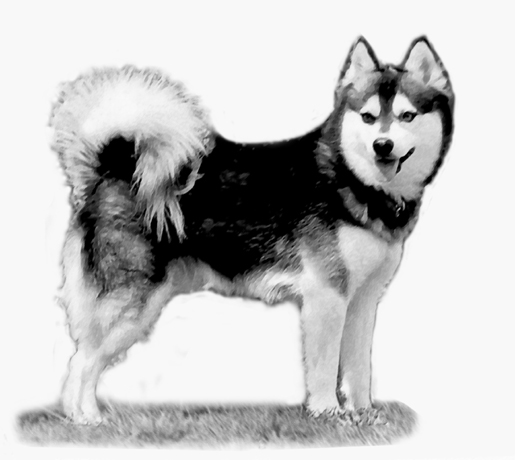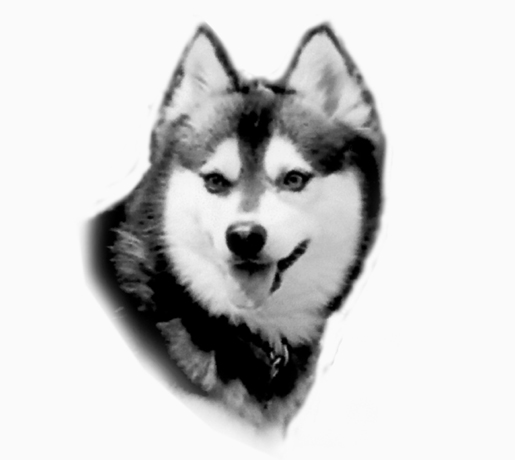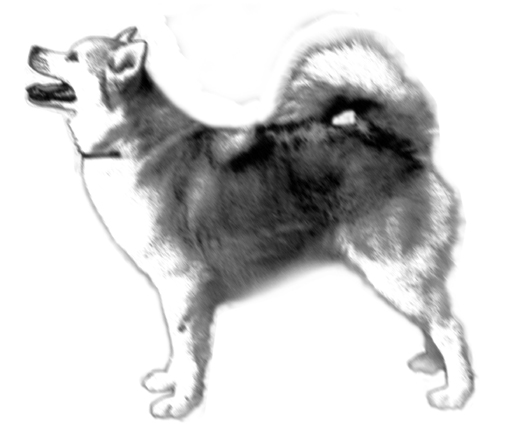|

The goals and purposes of this breed standard include: to furnish guidelines for
breeders who wish to maintain the quality of their breed and to improve it; to
advance this breed to a state of similarity throughout the world; and to act as
a guide for judges. Breeders and judges have the responsibility to avoid any
conditions or exaggerations that are detrimental to the health, welfare, essence
and soundness of this breed, and must take the responsibility to see that these
are not perpetuated.
Any departure from the following should be considered a fault, and the
seriousness with which the fault should be regarded should be in exact
proportion to its degree and its effect upon the health and welfare of the dog
and on the dog’s ability to perform its traditional work, which includes acting
as a companion.
Since the Alaskan Klee Kai is a breed developed through miniaturization,
particular attention should be paid to certain faults inherent with this
developmental process, especially taking into mind that faults can be
perpetuated because of a small gene pool. This includes, but is not limited to,
bulging eyes, unacceptable temperament, and fine bone.
HISTORY
The Alaskan Klee Kai was developed in Alaska by Linda Spurlin and her family, to
be a companion-sized version of a type of dog referred to as the Alaskan Husky.
From the early 70’s through 1988, the Spurlins carefully selected dogs who met
their high standards for appearance and soundness. In 1988, they made the
Alaskan Klee Kai available to others. Mrs. Spurlin originally called her new
breed the “Klee Kai”, but in 1995 it was changed to “Alaskan Klee Kai”.
The Alaskan Klee Kai was recognized by the United Kennel Club January 1, 1997.

GENERAL APPEARANCE
The Alaskan Klee Kai is a small version of a type of dog referred to as the
Alaskan Husky, with a wedge-shaped head featuring a striking masked face, prick
ears, and a double coat. The length of body is just slightly longer than the
height. The tail is well-furred and curls over the back or to either side when
the dog is alert or moving. The appearance of the Alaskan Klee Kai reflects the
breed’s Northern heritage.
Disqualifications: Unilateral
or bilateral cryptorchid. Viciousness or extreme shyness.
CHARACTERISTICS
The most distinctive characteristic of the Alaskan Klee Kai is the facial mask,
which must be clearly visible due to contrasting colors. The full face mask is
the most desirable. The Alaskan Klee Kai is very curious, active, quick and
agile. His loyalty and alertness make the Alaskan Klee Kai an excellent
watchdog, who may be territorial despite his small size. While affectionate with
family members, the Alaskan Klee Kai is reserved and cautious with strangers and
in unfamiliar situations.

HEAD
The head is clean, free of wrinkles, proportionate to the size of the body, with
a moderate stop. When viewed from the top or side, the skull and muzzle taper
toward the nose to form a broad-based wedge shape.
Faults:
Narrow head; insufficient stop; stop too steep.
SKULL - The skull is slightly rounded and somewhat broad, tapering gradually
from the widest point to the eyes.
Faults:
Skull too flat or too domed.
MUZZLE - The length of the muzzle, from stop to nose, is equal to or slightly
shorter than the length of the skull, from occiput to stop. When viewed from the
side or from above, the muzzle tapers slightly from where it joins the skull to
the nose. The muzzle is well-filled-in under the eyes. The lower jaw is strong,
but not protruding. Lips are tightly closed and black, except that liver-colored
lips are acceptable in dogs whose coat colors are shades of red with white.
Faults:
Loosely hanging lips; a shallow or receding lower jaw; a pinched or snipey
muzzle; a too short or too long muzzle.
TEETH - A full complement of strong white teeth meet in a scissors bite.
Fault:
Level bite.
Disqualifications:
Overshot or undershot bite, wry mouth.
NOSE - A solid black nose is preferred, although the pink-streaked “snow nose”
is acceptable. A liver-colored nose is acceptable in dogs whose coat colors are
shades of red with white.In
profile, the nose is on the same line as the top of the muzzle and extends just
slightly beyond the lower jaw.
EYES - The eyes are of medium size and may be any color or combination of
colors. Almond-shaped eyes are the most desirable, followed in order of
preference by oval and round. The eyes are set obliquely. Eye rims are black
except that liver eye rims are acceptable in dogs whose coat colors are shades
of red with white.
Faults:
Eyes set too wide or too close together.
Eliminating Fault: Bulging
eyes.
EARS - The ears are prick, strongly erect and pointed upward, well-furred,
triangular in shape, and slightly large in proportion to the size of the head.
The leather is thick from base to tip. The ears are set so that the inner edge
of each ear is above the inner half of the eye below it. Ear tips are slightly
rounded. The ears are extremely mobile and react sensitively to sounds.
Fault:
Ears set too low.
Disqualification:
Hanging or drop ears.
NECK
The neck is medium in length, arched, and carried proudly erect when the dog is
standing. When moving at a trot, the neck is extended so that the head is
carried slightly forward.
Faults:
Neck too short and thick; neck too long.
FOREQUARTERS
The shoulders are moderately laid back. The scapula and the upper arm form an
angle of about 110 degrees. The shoulder blade and the upper arm are roughly
equal in length.
FORELEGS - Viewed from the front, the forelegs are straight, parallel, and
spaced moderately apart, with moderate to fine bone in proportion to the size of
the dog. Pasterns are flexible and strong, moderately short, and slightly
sloping. Elbows are neither close to the body nor out, but are set on a plane
parallel to the body.
Faults:
Straight shoulders; weak pasterns; short upper arm. East-west front/feet turning
outward.
BODY
In profile, the length of the body, from the point of the shoulder to the rear
of the buttocks, is slightly longer than the height of the body from the withers
to the ground. The withers are just slightly higher than the croup. The topline
of the back is level from just behind the withers to the loin, which is slightly
arched. The croup is broad and very slightly sloping.
The ribs are well sprung out from the spine, forming a strong back, then curving
down and inward to form a body that would be nearly heart-shaped if viewed in
cross-section. The loin is strong and short but narrower than the rib cage and
with a slight tuck-up.
The chest is moderately broad and let down to the elbows. When viewed from the
side, the lowest point of the chest is immediately behind the foreleg. The
forechest should extend in a shallow oval shape in front of the forelegs but the
sternum should not be excessively pointed.
Faults:
Chest too broad; barrel or flat ribs; slack or roached back. High in rear.
HINDQUARTERS
Viewed from the rear, the rear pasterns are parallel to each other, and spaced moderately
apart. The rear legs are moderately
well angulated at stifle and hock joints. The rear pasterns are well let down
and perpendicular to the ground when viewed from any angle.
Serious Faults: Over-angulation;
hocks turned in or out; thin or weak thighs.
FEET
The feet are sized in proportion to the bone of the individual dog, oval in
shape, and well-knuckled up. The pads are thickly cushioned and well furred
between the toes and pads. Hair on the feet may be trimmed between the pads and
around the outer edges of the feet. All dewclaws should be removed.
Faults:
Splayed feet; long feet; poorly cushioned pads.
TAIL
The tail should be well furred and set on just below the level of the topline.
The preferred tail carriage is a loose curl, which falls to the center of the
back or drapes to either side of the body. The tail may hang down when the dog
is relaxed or in unfamiliar situations but forms a loose curl when the dog is
alert or moving. Dark hairs at the tip of the tail are preferred.
Faults:
Tail stands away from the back or sides of the body when curled.
Disqualification:
Tail too short to curl over and touch the back.
COAT
The coat is double and of sufficient length to give a well furred appearance
reminiscent of the breed’s Alaskan Husky heritage. The coat is never so long as
to obscure the outline of the dog. The neck is well furnished with hair, which
forms a protective ruff blending into the apron. The tail is well furred with
longer hair at the base and underside of the tail. Longer-coated dogs may have
some feathering on the rear of the front legs; the rear of the hindquarters,
from the buttocks to the hock joint; underside of the body and tail; and the
ears.
The undercoat is soft, dense, and of sufficient length to support the outer
coat. The guard hairs of the outer coat are straight and never harsh nor
extremely soft. The absence of undercoat during the shedding season is normal.
This breed is presented in a completely natural condition except that trimming
of hair between the pads and around the feet to present a neater appearance is
permissible.
Serious Faults:
Coat that is so long as to obscure the outline of the dog; trimming other than
described above.
COLOR
All coat colors acceptable provided that the facial mask is distinct and clearly
visible and there is a contrasting lighter color on the dog’s throat, chest,
breeches, feet, legs and underside. The overall appearance is one of symmetry.
The most desirable mask consists of dark coloration on the skull which extends
down the bridge of the muzzle and under the eyes, provided that the darker color
under the eyes extends no more than halfway down the muzzle; light spots over
the eyes; and a contrasting lighter color extending up the cheeks to a line
between the outside corners of the eyes and the base of the ears, down the sides
of the muzzle, under the jaw, and down the throat. The fur on the inside of the
ears should also be of the same lighter contrasting color.
Any of the following markings are very desirable but it is not necessary that
all be present: Light spots over the eyes; a light blaze centered in the middle
of the skull and stop; a dark strip down the center of the muzzle which may or
may not be evenly divided by a narrow light-colored strip; dark coloration under
the eyes; and dark coloration at the tip of the tail. With the exception of the
blaze and the light spots above the eyes, the more of the lighter contrasting
color present on the upper part of the face, the less desirable is the mask,
with the least acceptable being the Widow’s Peak (where the entire face is of
the lighter color with just a small dark area capping the top of the head and a
point dropping into the center of the upper forehead).
Eliminating Faults:
Absence of required lighter contrasting color described above; asymmetrical
markings visible while the dog is standing; any distinct area of lighter
contrasting color on the topline, known as a “cape”; a dark strip on the center
of the muzzle that extends down the sides of the muzzle; distinct spots of
lighter contrasting color anywhere other than the spots over the eyes, the blaze
on the head, or the tip of the tail. An all-white dog.
Disqualifications:
Absence of distinct mask; solid coat color (other than white) lacking distinct
and contrasting markings; albinism.
HEIGHT & WEIGHT
It is intended that the Alaskan Klee Kai remain a small to medium-sized dog.
Height is measured from the withers to the ground. An Alaskan Klee Kai should
not appear heavy or too thin. Weight should be proportionate to height.
Toy Variety: Up to and including 13 inches.
Miniature Variety: Over 13 inches and up to and including 15 inches.
Standard Variety: Over 15 inches up to and including 17 inches.
Serious Fault:
Over 17 inches up to and including 17˝ inches.
Eliminating Fault: Over
17˝ inches in height.
GAIT
The Alaskan Klee Kai should move with the smooth, effortless, agile gait of his
Arctic forebears. When in the show ring, they should be gaited on a loose lead
at a moderately fast trot, exhibiting good reach in the forequarters and good
drive in the hindquarters. When viewed from front to rear while moving at a
walk, the Alaskan Klee Kai does not single-track, but as the speed increases,
the legs gradually angle inward until the pads are falling on a line directly
under the longitudinal center of the body. As the pad marks converge, the
forelegs and hind legs are carried straight forward, with neither elbows nor
stifles turned in or out. While the dog is gaiting, the topline remains firm and
appears level.
Faults:
Short, prancing or choppy gait, lumbering or rolling gait; crossing or crabbing.
SERIOUS FAULTS
Judges must penalize dogs with any one of the following serious faults and
withhold championship points from any dog possessingtwo
or more of these faults.
Breeders should take as strict or even stricter view of these serious faults in
their breeding program.
Coat: Coat
that is so long as to obscure the outline of the dog; trimming other than as
described in “Coat” paragraph.
Height and Weight: Over
17 inches up to and including 17˝ inches.
Hindquarters: Over
angulation; hocks turned in or out; thin or weak thighs.
ELIMINATING FAULTS
(An
Eliminating Fault is a Fault serious enough that it eliminates the dog from
obtaining any awards in a conformation event.)
Over 17˝ inches in height.
Bulging eyes.
Color: Absence
of required lighter contrasting color as described in “Color” paragraph;
asymmetrical markings visible while the dog is standing; any distinct area of
lighter contrasting color on the topline, known as a “cape”; a dark strip on the
center of the muzzle that extends down the sides of the muzzle; distinct spots
of lighter contrasting color anywhere other than the spots over the eyes, the
blaze on the head, or the tip of the tail. An all white dog.
DISQUALIFICATIONS
(A
dog with a Disqualification must not be considered for placement in a bench
show/conformation event, and must be
reported to UKC.)
Unilateral or bilateral cryptorchid. Viciousness or extreme shyness. Albinism.
Over or undershot bite. Wry mouth. Hanging or drop ears. Tail too short to curl
over and touch the back. Absence of mask. Solid coat color lacking distinct and
contrasting markings.
Please Note: In
UKC Conformation Shows, this breed is shown by variety in this order – Toy,
Miniature, Standard.
|